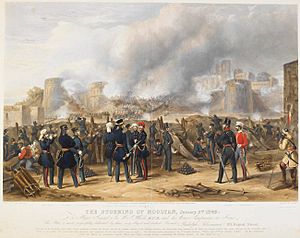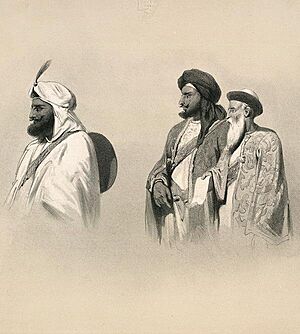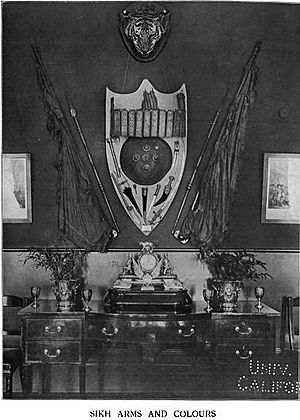Siege of Multan (1848-1849) facts for kids
Quick facts for kids Siege of Multan |
|||||||
|---|---|---|---|---|---|---|---|
| Part of the Second Anglo-Sikh War | |||||||
 The Storming of Mooltan, 2nd Jan 1849 |
|||||||
|
|||||||
| Belligerents | |||||||
| Commanders and leaders | |||||||
| Gen. Whish | Diwan Mulraj Chopra | ||||||
| Strength | |||||||
| 32,000 troops 150 guns |
12,000 troops 66 guns |
||||||
| Casualties and losses | |||||||
| 5,000 | 2,500 | ||||||
The Siege of Multan was a big fight that happened between April 19, 1848, and January 22, 1849. It took place around the city of Multan, which is now in Pakistan. This battle was between the East India Company (a British trading company that also had an army) and the Sikh Empire.
The fighting started because of a rebellion against a new ruler chosen by the East India Company. This event helped kick off the Second Anglo-Sikh War. The siege ended when the last defenders of Multan gave up to the British forces.
Contents
Why the Siege Started: The Background
Multan became part of the Sikh Empire in 1818, under Ranjit Singh. By 1845, even though many people in Multan were Muslim, a Hindu leader named Dewan Mulraj ruled it. He was like a local governor, but he had to answer to the Sikh Empire.
In 1845, the First Anglo-Sikh War happened, and the British East India Company won. After this, there was a shaky peace. Mulraj tried to keep Multan mostly independent, even though he was supposed to be under the East India Company's control.
Multan's Importance and New Demands
By 1848, Multan was a busy city with 80,000 people. It was a major trading hub, known for its wealth, spices, silks, and other valuable goods.
Early in 1848, a new British official, Sir Frederick Currie, arrived in Punjab. He told Mulraj that he needed to pay taxes and duties that were owed to the Sikh Empire's main government, which the British now controlled. Mulraj tried to avoid the British taking over Multan completely. He offered to step down and let his son rule instead.
However, Currie decided to put a different Sikh ruler, Sardar Khan Singh, in charge. Khan Singh was to be joined by a British officer, Patrick Vans Agnew, who would make sure things ran smoothly.
The Revolt in Multan: A Sudden Uprising
On April 18, Vans Agnew and another British officer, Lieutenant Anderson, arrived near Multan with a small group of soldiers called Gurkhas. The next day, Mulraj seemed to hand over control of the city's fort peacefully to Khan Singh and the two British officers.
Attack on British Officers
But as Vans Agnew and Anderson were leaving the fort, a soldier from Mulraj's army attacked Vans Agnew. This attack might have been a signal for a bigger uprising. Soon, a large crowd surrounded and attacked the officers. Mulraj's own soldiers either watched or joined the angry crowd.
Both British officers were hurt. They, along with Khan Singh, went to a nearby mosque outside the city for safety. Anderson quickly wrote a message asking for help. One messenger took it to Currie in Lahore, and another took a copy by a different route.
The Officers are Killed
During the night, most of Vans Agnew's guards left. The next morning, the angry crowd pushed Khan Singh aside and killed the two British officers.
It's thought that Mulraj himself might not have planned this attack. But because his soldiers had done it, he felt he had to join the rebellion. He even sent Vans Agnew's head to Khan Singh, telling him to take it back to Currie.
Fighting Begins: The Battle of Kineyri
Lieutenant Herbert Edwardes, another British officer, was the first to act against Mulraj's revolt. He got a copy of Vans Agnew's letter and quickly gathered troops. Edwardes and other young British officers were frustrated because Currie in Lahore didn't want to do anything during the hot summer and rainy seasons. This was partly to save money and because they weren't ready. Also, the Governor General and the army commander didn't want to send European soldiers to fight in such harsh weather.
Meanwhile, Mulraj's army grew stronger. Many other regiments from the Sikh Khalsa Army, the Sikh Empire's army, joined his rebellion or left their posts to help him. Mulraj also worked to make his defenses better, digging up old cannons and getting more soldiers.
Edwardes's Army Advances
In early June, Edwardes led his army towards Multan. On June 18, his first troops, who were Pashtun fighters, crossed the Chenab River. Mulraj's cannons fired at them, forcing them to hide for several hours. Mulraj's foot soldiers and cavalry then started to move forward.
But Edwardes got help from two regiments of the Sikh Khalsa Army led by Colonel Van Cortlandt, a soldier of mixed heritage. Van Cortlandt's cannons caused heavy losses among Mulraj's troops. Edwardes's Pashtuns then attacked back. Mulraj's forces had to retreat to Multan, having lost 500 men and six cannons.
Sher Singh's Change of Sides
After Currie heard about Edwardes's victory, he finally ordered a smaller British force, led by General Whish, to start the siege of Multan. This force was too small to surround the whole city. So, Currie decided to send more help: a large group of Sikh soldiers from the Khalsa army, led by Sher Singh Attariwalla.
Many British officers were worried about Sher Singh's appointment. His father, Chattar Singh Attariwalla, seemed to be planning a rebellion in the north. Despite these warnings, Currie ordered a group of soldiers from Chattar Singh's army to join Sher Singh. This allowed Chattar Singh's officers to influence Sher Singh and spread ideas of rebellion among his soldiers.
The Besieging Forces
At this point, the forces trying to capture Multan included:
- Whish's division: 8,089 men, 32 large cannons, 12 smaller cannons.
- Edwardes's irregular troops: 4,033 cavalry (horse soldiers) and 7,718 infantry (foot soldiers).
- Soldiers from the Muslim state of Bahawalpur: 1,900 cavalry and 5,700 infantry.
- Sher Singh's force: 3,382 cavalry and 909 infantry.
On September 14, Sher Singh openly rebelled against the East India Company. This made the British forces too weak to continue the siege, and they had to pull back. Most of Edwardes's and the Bahawalpur troops went home. Even though Sher Singh and Mulraj were both against the British, they didn't work together. They met and agreed that Sher Singh would move north into areas where most people were Sikh.
The Main Siege of Multan
In late November, General Whish received a large number of new soldiers from the East India Company's Bombay Army. Some people said that these new soldiers were very good at tasks like digging trenches, which helped a lot during the siege.
Whish's combined army now had 32,000 soldiers. About 15,000 of these were British or European troops. They also had 150 cannons, many of them very powerful. It was easy to get supplies for this large army because Multan was close to the Indus River. Steamships could bring supplies close to the city.
Inside the City Walls
Inside Multan, Mulraj had 12,000 soldiers, with 54 cannons and 12 mortars (a type of cannon that fires shells high into the air). Some reports say there were 80 cannons in the fort, but some might have been old or just for show.
On December 27, Whish ordered his troops to attack the areas just outside the city walls. Mulraj's forces were pushed back into the city. Whish's army then set up their cannons about 500 yards from the city walls. Under the cover of their fire, they moved closer, setting up cannons only 80 yards from the walls. These cannons made two large holes in the walls and caused a lot of damage inside the city.
The Great Explosion
On December 30, a huge explosion happened inside the fort. The main storage area for gunpowder, which was in a mosque, blew up. It held 180 tons of gunpowder! A British mortar shell hit it, causing the explosion. This is considered one of the biggest non-nuclear explosions in history. About 800 of the defenders were killed.
Despite this disaster, Mulraj kept fighting. He sent a message to Whish saying he still had enough gunpowder for a year. He tried to attack the British on December 31, but his attack was pushed back.
Final Attack and Surrender
Whish ordered a full attack on January 2, 1849. The attackers successfully climbed through the holes in the walls. The battle then became a fierce fight from house to house inside the city. Many defenders and regular people were killed. Whish ordered civilians to be gathered in the main square, perhaps to protect them, but this also led to more deaths.
With the city captured, only the damaged fort remained. It held out for two more weeks against heavy bombing. On January 18, British engineers exploded three mines under the fort's walls, causing more damage and losses. Mulraj offered to surrender if his life was spared. However, Whish demanded that Mulraj surrender without any conditions. So, on January 22, Mulraj gave himself up with 550 of his men.
After the Siege: What Happened Next
After Multan fell, the British found a huge amount of treasure. Mulraj's treasury was worth about three million pounds, which was a massive sum of money back then. There was also a lot of looting in the city by both British and Indian soldiers.
With Multan captured, General Whish's army could now join the main British army under Sir Hugh Gough. Whish's powerful cannons were very important in the Battle of Gujarat. This battle effectively defeated Sher Singh's and Chattar Singh's armies and ended the war.
Mulraj was put on trial for the deaths of Vans Agnew and Anderson. He was found responsible for their deaths because he had rewarded the attackers and used their deaths as a reason for his rebellion. Mulraj was sentenced to live away from his home for the rest of his life.
In August 1849, the Indus and Chenab rivers flooded. The heavily damaged fort of Multan was washed away, becoming just an "island of mud" in the floods.
Images for kids





